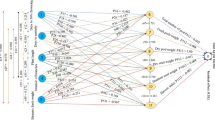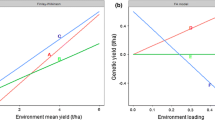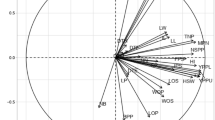Abstract
In order to investigate the agricultural potential of the genus Vicia, and identify traits associated with productivity and responsiveness to environment, 34 undomesticated Mediterranean accessions representing Section Narbonensis (V. johannis, V. narbonensis) and V. sativa were grown in five contrasting environments in northern Syria (growing season rainfall: 76–290 mm).Highly significant genotype × environment interactions were observed for all traits. For most of the components of yield, accession mean performance (productivity)was highly correlated with responsiveness across environments (r = 0.59–0.96), as defined by joint linear regressions. Thus high yielding genotypes tended to be relatively more productive than low yielding genotypes under conditions that favoured high yields. Regression analysis revealed that mean site yields were positively correlated to rainfall (r = 0.85) and its attendant effect on growing season length as measured by cumulative season temperature and phenology (r = 0.59–0.81).In order to examine yield related traits independently of taxonomy, genotypes were grouped into three categories using K-means clustering based on productivity and responsiveness of seed, hay and biological yield. Highly productive/responsive genotypes were tall with high harvest index, large seeds and low fecundity (seeds and pods per plant), whereas unproductive/unresponsive plants tended to be short, highly fecund, with small seeds and low harvest index. Principal components analysis showed that responsiveness, in terms of seed, hay and biological yields, was closely related to phenological plasticity. Thus highly productive/responsive genotypes were able to start flowering earlier than unproductive/unresponsive genotypes in early environments, but significantly later in late, higher rainfall environments. Plant growth habit was also related to yield responsiveness. In environments with little biomass production the proportion of erect plants was high in all three categories. In more favourable, high biomass environments, the proportion of erect plants in unproductive/unresponsive genotypes fell dramatically, but was unchanged among productive/responsive genotypes. We suggest that for unproductive/unresponsive genotypes competition for light is increased under optimal growth conditions. We argue that the optimal combination of fixed and responsive traits in high yielding genotypes results in a `compound interest-type' response to more favourable environments. Highly productive and responsive genotypes can capture resources more effectively than their low yielding counterparts, leading to a positive relationship between performance and responsiveness for most components of yield. Differences in productivity and responsiveness for seed, hay and biological yield reflected Vicia taxonomy, increasing in the following order from low to high: V. johannis, V. sativa, the small seeded V. narbonensis (salmonea, jordanica, affinis) V. n. var. narbonensis, and finally V. n. var.aegyptiaca. V. n. var. aegyptiaca showed the most agricultural potential, since the taxon contained all the properties of productive/responsive genotypes listed above, yielding >1 t/ha under extremely arid conditions (104 mm),and >2.5 t/ha on 290 mm rainfall, confirming its potential for dry environments.
Similar content being viewed by others
References
Abd El Moneim, A.M., 1992. Narbon vetch (Vicia narbonensis L.) A potential feed legume crop for dry areas in west Asia. J Agron Crop Sci 169: 347–353.
Abd El Moneim, A.M., 1993a. Agronomic potential of three vetches (Vicia spp.) under rainfed conditions. J Agron Crop Sci 170: 113–120.
Abd El Moneim, A.M., 1993b. Selection for non-shattering common vetch (V. sativa L.). Plant Breed 110: 168–171.
Abd El Moneim, A.M., P. Cocks & Y. Swedan, 1988. Yield stability of selected forage vetches (Vicia spp.) under rainfed conditions in west Asia. J Agric Sci 111: 295–302.
Baker, H.G., 1972. Seed weight in relation to environmental conditions in California. Ecology 53: 997–1010.
Berger, J.D., 2000. Phenology, Productivity, and Seed Anti-Nutritional Factors: Investigations into Adaptation and the Domestication of Mediterranean Vicia Species. PhD, University of Western Australia, Perth.
Berger, J.D., L.D. Robertson & P.S. Cocks, 2000. Agricultural potential of Mediterranean grain and forage legumes: 1) Key differences between and within Vicia species in terms of phenology, yield, and agronomy give insight into plant adaptation to semi-arid environments. Genet Res Crop Evol (in press).
Cakmakci, S. & E. Acikgoz, 1994. Components of seed and straw yield in common vetch (Vicia sativa L.). Plant Breed 113: 71–74.
Cocks, P.S., 1995. Genotype x site interactions in seed production, hard seed breakdown and regeneration of annual medics (Medicago spp.) in west Asia. J Agric Sci 125: 199–209.
Cooper, P.J., A.Y. Allan, K. Harmsen, J.D. Keatinge, D. Nygaarde, M. Saxena & R. Islam, 1981. Soil Water and Nutrient Research, 1979-1980, Rep. No. 3. ICARDA, Aleppo, Syria.
Eberhart, S.A. & W.A. Russell, 1966. Stability parameters for comparing varieties. Crop Sci 3: 36–40.
Ehrman, T. & P.S. Cocks, 1996. Reproductive patterns in annual legume species on an aridity gradient. Vegetatio 122: 47–59.
Fernandez-Ales, R., J.M. Laffarga & F. Ortega, 1993. Strategies in Mediterranean grassland annuals in relation to stress and disturbance. J Veg Sci 4: 313–322.
Finlay, K.W. & G.N. Wilkinson, 1963. The analysis of adaptation in a plant breeding programme. Aust J Agric Res 14: 742–754.
Grime, J.P., 1979. Plant Strategies and Vegetation Processes, Wiley & Sons.
Maxted, N., 1995. An Ecogeographical Study of Vicia Subgenus Vicia, IPGRI, Rome.
Siddique, K.H.M. & S.P. Loss, 1996. Growth and seed yield of vetches (Vicia spp.) in south-western Australia. Aust J Exp Agric 36: 587–593.
Siddique, K.H.M., S.P. Loss & D. Enneking, 1996. Narbon bean (Vicia narbonensis L.): A promising grain legume for low rainfall areas of south-western Australia. Aust J Exp Agric 36: 53–62.
Siddique, K.H.M., S.P. Loss, K.L. Regan & R.L. Jettner, 1999. Adaptation and seed yield of cool season grain legumes in Mediterranean environments of south-western Australia. Aust J Agric Res 50: 375–387.
Stebbins, G.L., 1976. Seed and seedling ecology in annual legumes. I. A comparison of seed size and seedling development in some annual species. Oecologia Plantarum 11: 321–331.
Thornley, J.H.M. & I.R. Johnson, 1990. Light in Relation to Canopies. Plant and Crop Modelling, pp. 197–212. Clarendon Press, Oxford.
Author information
Authors and Affiliations
Rights and permissions
About this article
Cite this article
Berger, J., Robertson, L. & Cocks, P. Genotype × environment interaction for yield and other plant attributes among undomesticated Mediterranean Vicia species. Euphytica 126, 421–435 (2002). https://doi.org/10.1023/A:1019938300971
Issue Date:
DOI: https://doi.org/10.1023/A:1019938300971




